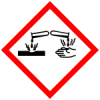The Producer has a plan to phase out by 2024 pesticides listed in category 2 of the Globally Harmonized System of Classification and Labelling of…
Coalition status
Details
Toxicty
GHS safety labels
- H317

May cause an allergic skin reaction
Class: Sensitization
Subclass: Skin - H318

Causes serious eye damage
Class: (Corrosion)Damage/irritation
Subclass: Eye - H330

Fatal if inhaled
Class: Acute Toxicity
Subclass: Inhalation - H335

May cause respiratory irritation
Class: STOT-respiratory irritation
Subclass: Single exposure - H351

Suspected of causing cancer (state route of exposure if it is conclusively proven that no other routes of exposure cause the hazard)
Class: Carcinogenicity - H400

Very toxic to aquatic life
Class: Aquatic
Subclass: Acute - H410

Very toxic to aquatic life with long lasting effects
Class: Aquatic
Subclass: Chronic
